Kenjiro Tadakuma
Passive Luminescent Bellows Mechanism
Apr 05, 2025



Abstract:The use of robots in disaster sites has rapidly expanded, with soft robots attracting particular interest due to their flexibility and adaptability. They can navigate through narrow spaces and debris, facilitating efficient and safe operations. However, low visibility in such environments remains a challenge. This study aims to enhance the visibility of soft robots by developing and evaluating a passive luminescent exible actuator activated by a black light. Using Ecoex mixed with phosphorescent powder, we fabricated an actuator and confirmed its fluorescence phosphorescence and deformation ability. Furthermore the effects of the mixing ratio on optical and mechanical properties were assessed.
Reflexive Input-Output Causality Mechanisms
Oct 14, 2024



Abstract:This paper explores the concept of reflexive actuation, examining how robots may leverage both internal and external stimuli to trigger changes in the motion, performance, or physical characteristics of the robot, such as its size, shape, or configuration, and so on. These changes themselves may in turn be sequentially re-used as input to drive further adaptations. Drawing inspiration from biological systems, where reflexes are an essential component of the response to environmental changes, reflexive actuation is critical to enable robots to adapt to diverse situations and perform complex tasks. The underlying principles of reflexive actuation are analyzed, with examples provided from existing implementations such as contact-sensitive reflexive arms, physical counters, and their applications. The paper also outlines future directions and challenges for advancing this research area, emphasizing its significance in the development of adaptive, responsive robotic systems.
A Modular, Tendon Driven Variable Stiffness Manipulator with Internal Routing for Improved Stability and Increased Payload Capacity
May 03, 2024



Abstract:Stability and reliable operation under a spectrum of environmental conditions is still an open challenge for soft and continuum style manipulators. The inability to carry sufficient load and effectively reject external disturbances are two drawbacks which limit the scale of continuum designs, preventing widespread adoption of this technology. To tackle these problems, this work details the design and experimental testing of a modular, tendon driven bead-style continuum manipulator with tunable stiffness. By embedding the ability to independently control the stiffness of distinct sections of the structure, the manipulator can regulate it's posture under greater loads of up to 1kg at the end-effector, with reference to the flexible state. Likewise, an internal routing scheme vastly improves the stability of the proximal segment when operating the distal segment, reducing deviations by at least 70.11%. Operation is validated when gravity is both tangential and perpendicular to the manipulator backbone, a feature uncommon in previous designs. The findings presented in this work are key to the development of larger scale continuum designs, demonstrating that flexibility and tip stability under loading can co-exist without compromise.
Biological Organisms as End Effectors
Jun 12, 2023Abstract:In robotics, an end effector is a device at the end of a robotic arm that is designed to physically interact with objects in the environment or with the environment itself. Effectively, it serves as the hand of the robot, carrying out tasks on behalf of humans. But could we turn this concept on its head and consider using living organisms themselves as end effectors? This paper introduces a novel idea of using whole living organisms as end effectors for robotics. We showcase this by demonstrating that pill bugs and chitons -- types of small, harmless creatures -- can be utilized as functional grippers. Crucially, this method does not harm these creatures, enabling their release back into nature after use. How this concept may be expanded to other organisms and applications is also discussed.
Flexible and slim device switching air blowing and suction by a single airflow control
Mar 08, 2023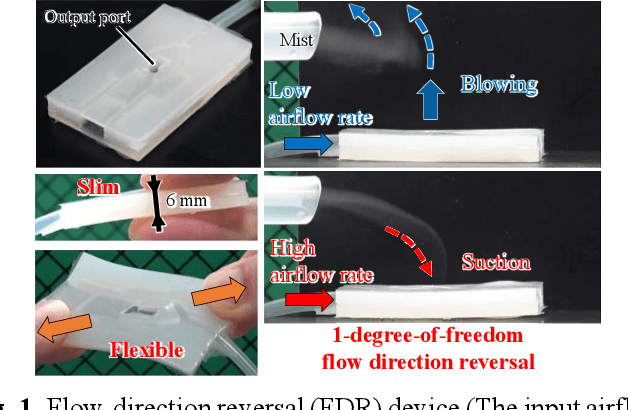
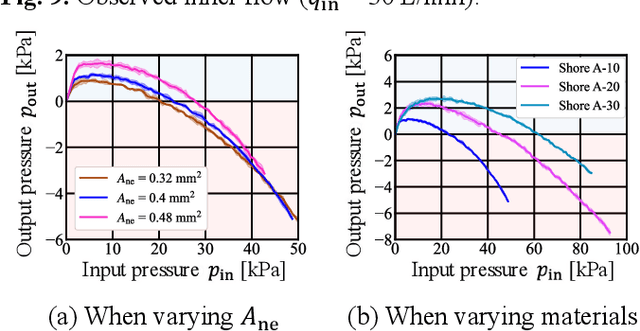
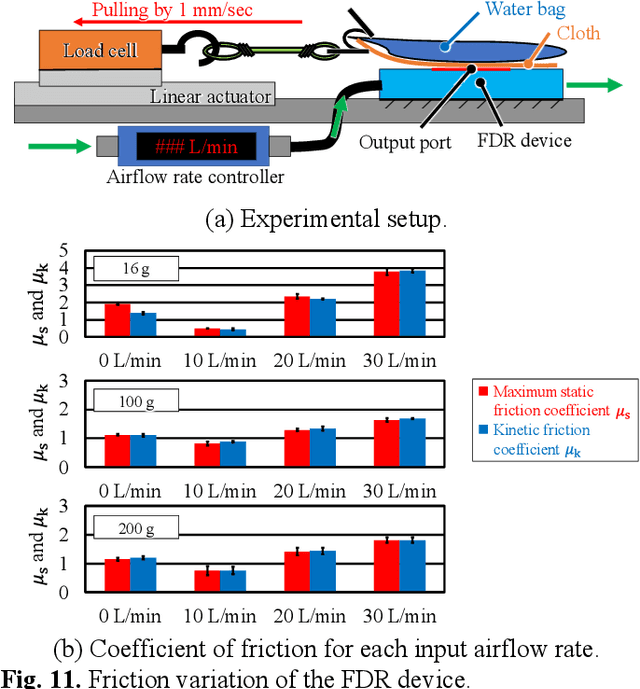
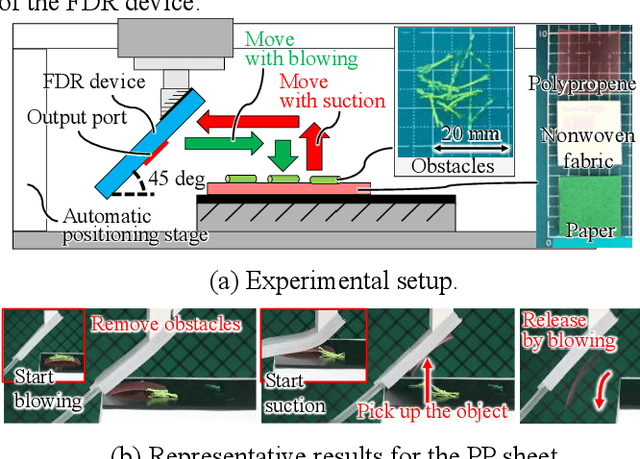
Abstract:This study proposes a soft robotic device with a slim and flexible body that switches between air blowing and suction with a single airflow control. Suction is achieved by jet flow entraining surrounding air, and blowing is achieved by blocking and reversing jet flow. The thin and flexible flap gate enables the switching. Air flow is blocked while the gate is closed and passes through while the gate is open. The opening and closing of the flap gate are controlled by the expansion of the inflatable chambers installed near the gate. The extent of expansion is determined by the upstream static pressure. Therefore, the gate can be controlled by the input airflow rate. The dimensions of the flap gate are introduced as a design parameter, and we show that the parameter contributes to the blowing and suction capacities. We also experimentally demonstrate that the proposed device is available for a variable friction system and an end effector for picking up a thin object covered with dust.
Soft robotic hand with finger-bending/friction-reduction switching mechanism through 1-degree-of-freedom flow control
Mar 28, 2022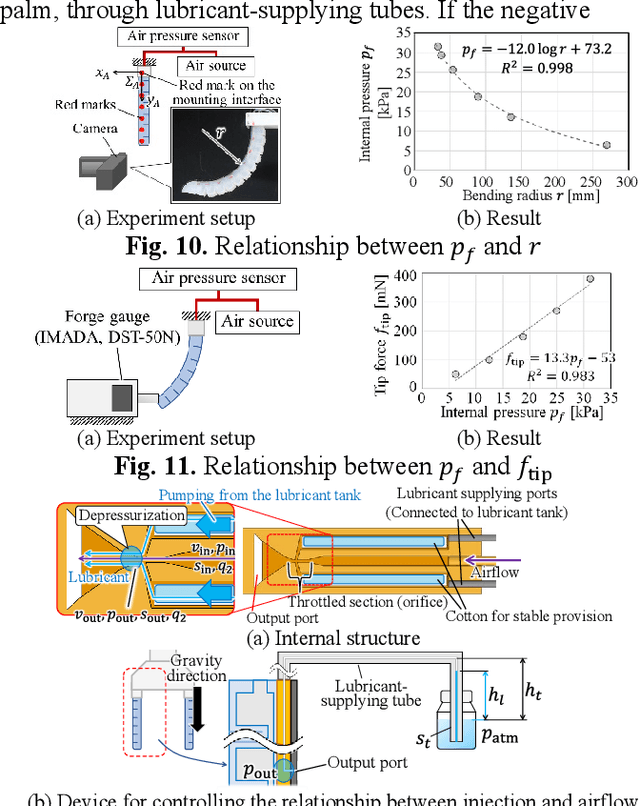
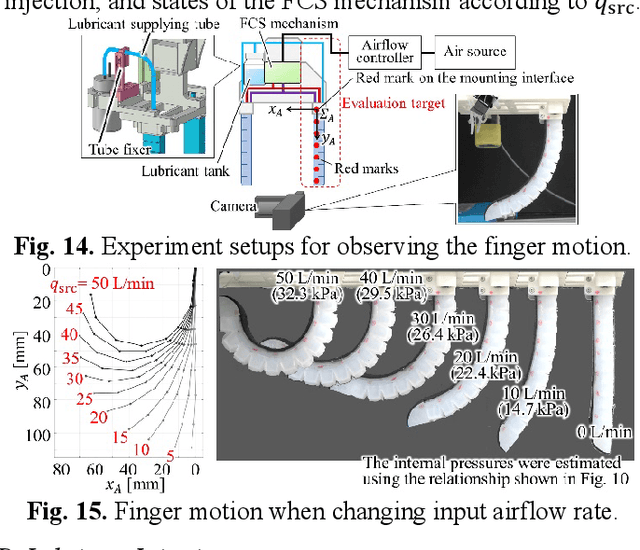

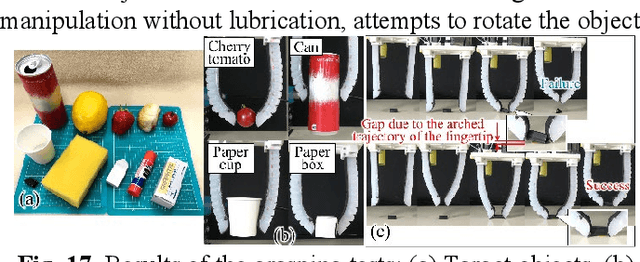
Abstract:This paper proposes a novel pneumatic soft robotic hand that incorporates a mechanism that can switch the airflow path using a single airflow control. The developed hand can control the finger motion and operate the surface friction variable mechanism. In the friction variable mechanism, a lubricant is injected onto the high-friction finger surface to reduce surface friction. To inject the lubrication using a positive-pressure airflow, the Venturi effect is applied. The design and evaluation of the airflow-path switching and friction variable mechanisms are described. Moreover, the entire design of a soft robotic hand equipped with these mechanisms is presented. The performance was validated through grasping, placing, and manipulation tests.
Sound masking degrades perception of self-location during stepping: A case for sound-transparent spacesuits for Mars
Feb 10, 2022
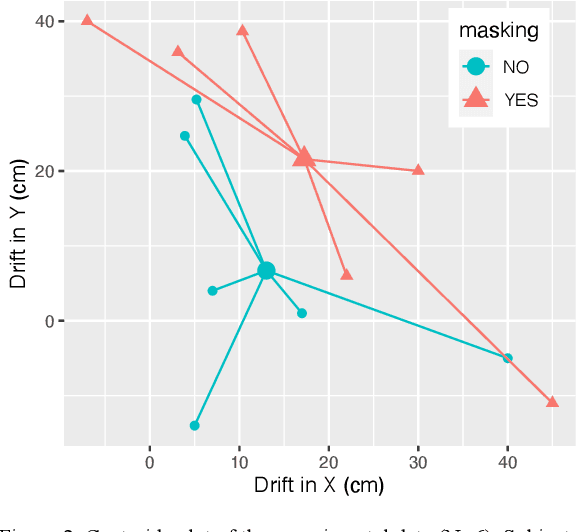
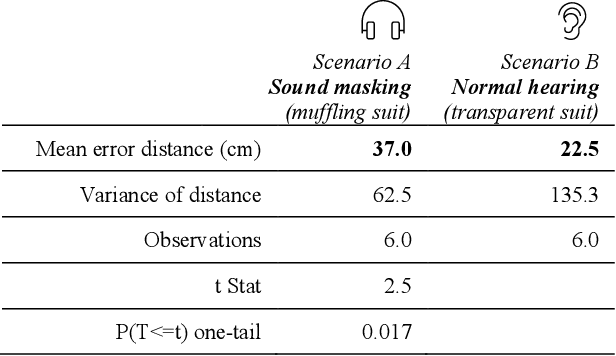
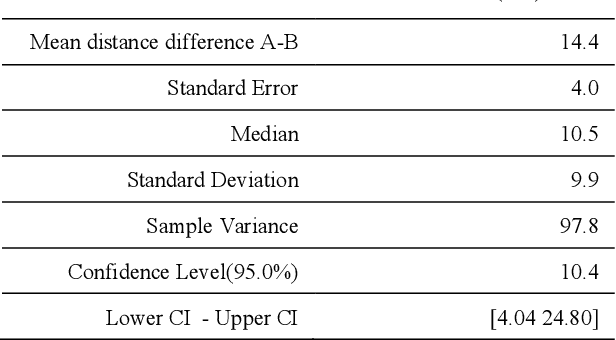
Abstract:Most efforts to improve spacesuits have been directed towards adding haptic feedback. However, sound transparency can also improve situational awareness at a relatively low cost. The extent of the improvement is unknown. We use the Fukuda-Unterberger stepping test to measure the accuracy of one's perception of self-location. We compare accuracy outcomes in two scenarios: one where hearing is impaired with sound masking with white noise and one where it is not. These scenarios are acoustic proxies for a sound muffling space suit and a sound transparent space suit respectively. The results show that when sound masking is applied, the error in self-location increases by 14.5cm, 95% CI [4.04 28.22]. Suggestions to apply the findings to Mars spacesuit designs are discussed. A cost-benefit analysis is also provided.
Inflated Bendable Eversion Cantilever Mechanism with Inner Skeleton for Increased Payload Holding
Feb 09, 2022



Abstract:Inflatable structures used in soft robotics applications exhibit unique characteristics. In particular, the tip-extension structure, which grows from the tip, can grow without friction against the environment. However, these inflatable structures are inferior to rigid mechanisms in terms of their load-bearing capacity. The stiffness of the tip-extension structure can be increased by pressurization, but the structure cannot maintain its curved shape and compliance. In this study, we proposed a mechanism that combines a skeleton structure consisting of multi-joint links with functions to increase rigidity while keeping low pressure and realizing the functions of bending and shape fixation. We devised a design method for rigid articulated links and combined it with a membrane structure that utilizes the advantages of the tip-extension structure. The experimental results show that the payload of the designed structure increases compared to that of the membrane-only structure. The findings of this research can be applied to long robots that can be extended in the air without drooping and to mechanisms that can wrap around the human body.
Hundred Drones Land in a Minute
Mar 11, 2020



Abstract:Currently, drone research and development has received significant attention worldwide. Particularly, delivery services employ drones as it is a viable method to improve delivery efficiency by using a several unmanned drones. Research has been conducted to realize complete automation of drone control for such services. However, regarding the takeoff and landing port of the drones, conventional methods have focused on the landing operation of a single drone, and the continuous landing of multiple drones has not been realized. To address this issue, we propose a completely novel port system, "EAGLES Port," that allows several drones to continuously land and takeoff in a short time. Experiments verified that the landing time efficiency of the proposed port is ideally 7.5 times higher than that of conventional vertical landing systems. Moreover, the system can tolerate 270 mm of horizontal positional error, +-30 deg of angular error in the drone's approach (+-40 deg with the proposed gate mechanism), and up to 1.9 m/s of drone's approach speed. This technology significantly contributes to the scalability of drone usage. Therefore, it is critical for the development of a future drone port for the landing of automated drone swarms.
Retraction Mechanism of Soft Torus Robot with a Hydrostatic Skeleton
Mar 11, 2020



Abstract:Soft robots have attracted much attention in recent years owing to their high adaptability. Long articulated soft robots enable diverse operations, and tip-extending robots that navigate their environment through growth are highly effective in robotic search applications. Because the robot membrane extends from the tip, these robots can lengthen without friction from the environment. However, the flexibility of the membrane inhibits tip retraction. Two methods have been proposed to resolve this issue; increasing the pressure of the internal fluid to reinforce rigidity, and mounting an actuator at the tip. The disadvantage of the former is that the increase is limited by the membrane pressure resistance, while the second method adds to the robot complexity. In this paper, we present a tip-retraction mechanism without bending motion that takes advantage of the friction from the external environment. Water is used as the internal fluid to increase ground pressure with the environment. We explore the failure pattern of the retraction motion and propose plausible solutions by using hydrostatic skeleton robot. Additionally, we develop a prototype robot that successfully retracts by using the proposed methodology. Our solution can contribute to the advancement of mechanical design in the soft robotics field with applications to soft snakes and manipulators.
 Add to Chrome
Add to Chrome Add to Firefox
Add to Firefox Add to Edge
Add to Edge